Characteristics and Geological Significance of Organic Matter Veins in Shale Reservoir: A Case Study of the Silurian Longmaxi Formation in Luzhou Area, Sichuan Basin
Abstract
:1. Introduction
2. Geological Setting
3. Samples and Methods
3.1. Research Samples
3.2. Experimental Method
4. Results
4.1. Morphological Characteristics
4.2. Reservoir Characteristics
5. Discussion
5.1. Formation Mechanism of OM Veins
5.2. Formation Period of OM Veins
5.3. Geological Significance of OM Veins
6. Conclusions
- (1)
- The OM veins mainly appear on the fracture wall, and some appear inside the quartz and calcite veins, most of them developed in the Long111 and Long112 layers.
- (2)
- The pore-forming efficiency of OM veins is lower than that of in-situ organic matter and organic matter in inorganic pores, the pores in the OM veins are sparse and the pore size is small.
- (3)
- The OM veins were formed after shale reached the fracture limit, in the late stage of organic matter migration to inorganic pores, and before mineral veins are filled.
- (4)
- The existence of OM veins can indicate high-quality reservoir conditions. The representative horizons have strong hydrocarbon generation strength (strong pore-forming ability of organic matter) and high brittle mineral content (strong reservoir compressibility), which makes the horizons conducive to shale gas accumulation and fracturing.
Author Contributions
Funding
Data Availability Statement
Conflicts of Interest
References
- Qiu, Z.; Zou, C.N. Controlling factors on the formation and distribution of “sweet-spot areas” of marine gas shales in South China and a preliminary discussion on unconventional petroleum sedimentology. J. Asian Earth Sci. 2020, 194, 103989. [Google Scholar]
- Jarvie, D.M.; Hill, R.J.; Ruble, T.E.; Pollastro, R.M. Unconventional shale-gas systems: The Mississippian Barnett Shale of north-central Texas as one model for thermogenic shale-gas assessment. AAPG Bull. 2007, 91, 475–499. [Google Scholar]
- Wang, P.W.; Nie, H.K.; Liu, Z.B.; Sun, C.X.; Cao, Z.; Wang, R.Y.; Li, P. Differences in Pore Type and Pore Structure between Silurian Longmaxi Marine Shale and Jurassic Dongyuemiao Lacustrine Shale and Their Influence on Shale-Gas Enrichment. Minerals 2023, 13, 190. [Google Scholar]
- Loucks, R.G.; Reed, R.M.; Ruppel, S.C.; Hammes, U. Spectrum of pore types and networks in mudrocks and a descriptive classification for matrixrelated mudrock pores. AAPG Bulletin. 2012, 96, 1071–1098. [Google Scholar] [CrossRef] [Green Version]
- Jia, Y.Q.; Han, D.L.; Zhang, J.Z.; Wang, C.C.; Lin, W.; Ren, X.H.; Yang, C.Y.; Chang, L.C. Differences in Pore forming Efficiency among Organic Macerals and Its Restriction against Reservoir Quality: A Case Study Based on the Marine Shale Reservoir in the Longmaxi Formation, Southern Sichuan Basin, China. Lithosphere 2021, 97, 2700912. [Google Scholar]
- Wang, R.Y.; Hu, Z.Q.; Long, S.X.; Du, W.; Wu, J.; Wu, Z.H.; Nie, H.K.; Wang, P.W.; Sun, C.X.; Zhao, J.H. Reservoir characteristics and evolution mechanisms of the Upper Ordovician Wufeng-Lower Silurian Longmaxi shale, Sichuan Basin. Oil Gas Geol. 2022, 43, 353–364. [Google Scholar]
- Jia, Y.Q.; Liu, Z.P.; Ren, X.H.; Zhou, Y.B.; Zheng, A.L.; Zhang, J.; Han, D.L. Organic matter type differentiation process and main control mechanism: Case study of the Silurian Longmaxi Formation shale reservoir in Weiyuan area. Acta Sedimentol. Sin. 2021, 39, 341–352. [Google Scholar]
- Hu, Z.Q.; Du, W.; Peng, Y.M.; Zhao, J.H. Microscopic pore characteristics and the source-reservoir relationship of shale—A case study from the Wufeng and Longmaxi Formations in Southeast Sichuan Basin. Oil Gas Geol. 2015, 36, 1001–1008. [Google Scholar]
- Loucks, R.G.; Reed, R.M. Scanning-electron-microscope petrographic evidence for distinguishing organic-matter pores associated with depositional organic matter versus migrated organic matter in mudrocks. Gcags Trans. 2014, 64, 51–60. [Google Scholar]
- Xie, G.L.; Liu, S.G.; Jiao, K.; Deng, B.; Ye, Y.H.; Sun, W.; Li, Z.Q.; Liu, W.P.; Luo, C.; Li, Z.C. Organic pores in deep shale controlled by macerals: Classification and pore characteristics of organic matter components in Wufeng Formation-Longmaxi Formation of the Sichuan Basin. Nat. Gas Ind. 2021, 41, 23–34. [Google Scholar]
- Cardott, B.J.; Landis, C.R.; Curtis, M.E. Post-oil solid bitumen network in the Woodford Shale, USA-A potential primary migration pathway. Int. J. Geol. 2015, 139, 106–113. [Google Scholar]
- Wang, P.F.; Jiang, Z.X.; Lyu, P.; Jin, C.; Li, X.; Huang, P. Organic matter pores and evolution characteristics of shales in the Lower Silurian Longmaxi Formation and Lower Cambrian Niutitang Formation in peripherfy of Chongqing. Nat. Gas Geosci. 2018, 29, 997–1008. [Google Scholar]
- Curtis, M.E.; Cardott, B.J.; Sondergeld, C.H.; Rai, C.S. Development of organic porosity in the Woodford Shale with increasing thermal maturity. Int. J. Coal Geol. 2012, 103, 26–31. [Google Scholar]
- Gao, Z.; Fan, Y.; Xuan, Q.; Zheng, G. A review of shale pore structure evolution characteristics with increasing thermal maturities. Adv. Geo-Energy Res. 2020, 4, 247–259. [Google Scholar]
- Wang, R.Y.; Hu, Z.Q.; Nie, H.K.; Liu, Z.B.; Chen, Q.; Gao, B.; Liu, G.X.; Gong, D.J. Comparative analysis and discussion of shale reservoir characteristics in the Wufeng-Longmaxi and Niutitang formations: A case study of the well JY1 in SE Sichuan Basin and well TX1 in SE Guizhou area. Pet. Geol. Exp. 2018, 40, 639–649. [Google Scholar]
- Han, J.; Chen, B.; Zhao, X.B.; Zheng, C.; Zhang, J.M. Development characteristics and influential factors of organic pores in the Permian shale in the Lower Yangtze Region. Nat. Gas Ind. 2017, 37, 17–26. [Google Scholar]
- Nie, H.K.; He, Z.L.; Wang, R.Y.; Zhang, G.R.; Chen, Q.; Li, D.H.; Lu, Z.Y.; Sun, C.X. Temperature and origin of fluid inclusions in shale veins of Wufeng-Longmaxi Formations, Sichuan Basin, south China: Implications for shale gas preservation and enrichment. J. Pet. Sci. Eng. 2020, 193, 107329. [Google Scholar]
- Ougier-Simonin, A.; Renard, F.; Boehm, C.; Vidal-Gilbert, S. Microfracturing and microporosity in shales. Earth-Sci. Rev. 2016, 162, 198–226. [Google Scholar]
- Tan, R.; Wang, R.Y.; Huang, Y.H.; Yang, R.; Li, H.B.; Lu, K. Mechanism of the Enrichment and Loss Progress of Deep Shale Gas: Evidence from Fracture Veins of the Wufeng-Longmaxi Formations in the Southern Sichuan Basin. Minerals 2022, 12, 897. [Google Scholar]
- Yang, H.Z.; Zhao, S.X.; Liu, Y.; Wu, W.; Xia, Z.Q.; Wu, T.P.; Luo, C.; Fan, T.Y.; Yu, L.Y. Main controlling factors of enrichment and high-yield of deep shale gas in the Luzhou Block, southern Sichuan Basin. Nat. Gas Ind. 2019, 39, 55–63. [Google Scholar]
- Dong, M.; Gou, W.; Zhang, L.Y.; Wu, Z.H.; Ma, L.C.; Dong, H.; Feng, X.Q.; Yang, Y.H. Characteristics of paleotectonic stress field and fractures of Wufeng-Longmaxi Formation in Luzhou area, southern Sichuan Basin. Lithol. Reserv. 2022, 34, 43–51. [Google Scholar]
- Liu, Z.B.; Gao, B.; Zhang, Y.Y.; Du, W.; Feng, D.J.; Nie, H.K. Types and distribution of the shale sedimentary facies of the Lower Cambrian in Upper Yangtze area, South China. Pet. Explor. Dev. 2017, 44, 21–31. [Google Scholar]
- Gou, T.L.; Zhang, H.R. Formation and enrichment mode of Jiaoshiba shale gas field, Sichuan Basin. Pet. Explor. Dev. 2014, 41, 28–36. [Google Scholar]
- Guo, Y.H.; Li, Z.F.; Li, D.H.; Zhang, T.M.; Wang, Z.C.; Yu, J.F.; Xi, Y.T. Lithofacies palaeogeography of the Early Silurian in Sichuan area. J. Palaeogeogr. 2004, 6, 20–29. [Google Scholar]
- Wang, X.M.; Liu, L.F.; Wang, Y.; Sheng, Y.; Zheng, S.S.; Luo, Z.H. Control of lithofacies on pore space of shale from Longmaxi Formation, southern Sichuan Basin. Acta Pet. Sin. 2019, 40, 1192–1201. [Google Scholar]
- Ge, X.Y.; Mou, C.L.; Yu, Q.; Liu, W.; Men, X.; He, J.L. The geochemistry of the sedimentary rocks from the Huadi No. 1 well in the Wufeng-Longmaxi formations (Upper Ordovician-Lower Silurian), South China, with implications for paleoweathering, provenance, tectonic setting and paleoclimate. Mar. Pet. Geol. 2019, 103, 646–660. [Google Scholar]
- Yan, C.N.; Jin, Z.J.; Zhao, J.H.; Du, W.; Liu, Q.Y. Influence of sedimentary environment on organic matter enrichment in shale: A case study of the Wufeng and Longmaxi Formations of the Sichuan Basin, China. Mar. Pet. Geol. 2018, 92, 880–894. [Google Scholar]
- Wu, L.Y.; Lu, Y.C.; Jiang, S.; Liu, X.F.; He, G.S. Effects of volcanic activities in Ordovician Wufeng-Silurian Longmaxi period on organic-rich shale in the Upper Yangtze area, South China. Pet. Explor. Dev. 2018, 45, 806–816. [Google Scholar]
- Pu, B.L.; Dong, D.Z.; Wang, F.Q.; Wang, Y.M.; Huang, J.L. The effect of sedimentary facies on Longmaxi shale gas in southern Sichuan Basin. Geol. China 2020, 47, 111–120. [Google Scholar]
- Wang, S.F.; Dong, D.Z.; Wang, Y.M.; Li, X.J.; Huang, J.L.; Guan, Q.Z. Sedimentary geochemical proxies for paleoenvironment interpretation of organic-rich shale: A case study of the Lower Silurian Longmaxi Formation, southern Sichuan Basin, China. J. Nat. Gas Sci. Eng. 2016, 28, 691–699. [Google Scholar]
- Zhao, S.X.; Yang, Y.M.; Zhang, J.; Wang, L.S.; Wang, X.Z.; Luo, C.; Tian, C. Micro-layers division and fine reservoirs contrast of Lower Silurian Longmaxi Formation shale, Sichuan Basin, SW China. Nat. Gas Geosci. 2016, 27, 470–487. [Google Scholar]
- Gao, Z.Y.; Fan, Y.P.; Hu, Q.H.; Jiang, Z.X.; Huang, Z.L.; Wang, Q.Y.; Cheng, Y. Differential development characteristics of organic matter pores and their impact on reservoir space of Longmaxi Formation shale from the south Sichuan Basin. Pet. Sci. Bull. 2020, 5, 1–16. [Google Scholar]
- Wu, J.G.; Yuan, Y.; Niu, S.Y.; Wei, X.F.; Yang, J.J. Multiscale characterization of pore structure and connectivity of Wufeng-Longmaxi shale in Sichuan Basin, China. Mar. Pet. Geol. 2020, 120, 104514. [Google Scholar]
- Wang, H.; Zhou, S.; Li, S.; Zhao, M.; Zhu, T. Comprehensive characterization and evaluation of deep shales from Wufeng-Longmaxi Formation by LF-NMR technology. Unconv. Resour. 2022, 2, 1–11. [Google Scholar]
- Guo, X.S.; Li, Y.P.; Borjigen, T.; Wang, Q.; Yuan, T.; Shen, B.J.; Ma, Z.L.; Wei, F.B. Hydrocarbon generation and storage mechanisms of deep-water shelf shales of Ordovician Wufeng Formation-Silurian Longmaxi Formation in Sichuan Basin, China. Pet. Explor. Dev. 2020, 47, 193–201. [Google Scholar]
- Saif, T.; Lin, Q.Y.; Butcher, A.R.; Bijeljic, B.; Blunt, M.J. Multi-scale multi-dimensional microstructure imaging of oil shale pyrolysis using X-ray micro-tomography, automated ultra-high resolution SEM, MAPS Mineralogy and FIB-SEM. Appl. Energy 2017, 202, 628–647. [Google Scholar]
- Schneider, C.A.; Rasband, W.S.; Eliceiri, K.W. NIH Image to ImageJ: 25 years of image analysis. Nat. Methods 2012, 9, 671–675. [Google Scholar]
- Wang, Z.; Lyu, X.X.; Zhang, L.X.; Li, F.; Ouyang, S.Q.; Wang, R. Discovery of “quartz bridge” in Kuqa foreland thrust belt and its geological significance. Earth Sci. 2023, 48, 342–358. [Google Scholar]
- Wang, X.X.; Wan, Y.L. Significance of the organic clay polymer on oil and gas generation. China Offshore Oil Gas 1993, 7, 27–33. [Google Scholar]
- Zeng, L.B.; Ma, S.J.; Tian, H.; Xue, M.; Liu, G.P.; Lyu, W.Y. Research progress of natural fractures in organic rich shale. Earth Sci. 2022, 48, 1–15. [Google Scholar]
- Zeng, L.B.; Qi, J.F.; Wang, Y.X. Origin type of tectonic fractures and geological conditions in low-permeability reservoirs. Acta Pet. Sin. 2007, 28, 52–56. [Google Scholar]
- Lu, X.C.; Hu, W.X.; Fu, Q.; Miao, D.Y.; Zhou, G.J.; Hong, Z.H. Study of combination pattern of soluble organic matters and clay minerals in the immature source rocks in Dongying Depression, China. Sci. Geol. Sin. 1999, 34, 72–80. [Google Scholar]
- Zhang, Q.; Liang, F.; Pang, Z.L.; Zhou, S.W.; Lin, W. Quantitative influence of soluble organic matter on pore structure in transitional shale. Pet. Geol. Exp. 2018, 40, 730–738. [Google Scholar]
- Liu, D.D.; Guo, J.; Pan, Z.K.; Du, W.; Zhao, F.P.; Chen, Y.; Shi, F.L.; Song, Y.; Jiang, Z.X. Overpressure evolution process in shale gas reservoir: Evidence from the fluid inclusions in the fractures of Wufeng Formation-Longmaxi Formation in the southern Sichuan Basin. Nat. Gas Ind. 2021, 41, 12–22. [Google Scholar]
- Zhi, F.Q.; Li, Q.; Fan, D.H.; Zhang, C.M. Study on migration and accumulation of fractured mudstone reservoirs in Zhanhua Sag. Pet. Geol. Recovery Effic. 2004, 11, 27–29. [Google Scholar]
- Deng, M.; Duan, X.G.; Zhai, C.B.; Long, S.X.; Yang, Z.H.; Zheng, L.J.; Li, Z.C.; Cao, T.T. Variation in liquid hydrocarbon content during thermal simulation and its influence on physical property of shale. Oil Gas Geol. 2020, 41, 1310–1320. [Google Scholar]
- Pan, Z.K.; Liu, D.D.; Huang, Z.X.; Jiang, Z.X.; Song, Y.; Guo, J.; Li, C.X. Paleotemperature and paleopressure of methane inclusions in fracture cements from the Wufeng-Longmaxi shales in the Luzhou area, southern Sichuan Basin. Pet. Sci. Bull. 2019, 4, 242–253. [Google Scholar]
- Osborne, M.J.; Swarbrick, R.E. Mechanisms for generating overpressure in sedimentary basins: A reevaluation. AAPG Bull. 1997, 81, 1023–1041. [Google Scholar]
- Tian, H.; Zeng, L.B.; Xu, X.; Shu, Z.G.; Peng, Y.M.; Mao, Z.; Luo, B. Characteristics of natural fractures in marine shale in Fuling area, Sichuan Basin, and their influence on shale gas. Oil Gas Geol. 2020, 41, 474–483. [Google Scholar]
- Wu, Q.Y.; Han, D.L.; Zhang, J.Z.; Wang, C.C.; Ren, X.H.; Lin, Z.Z.; Su, M.M.; Zhu, Y.L.; Zhang, J. Influence of particle size effect on microfracture development in shale reservoir: A case study of the Silurian Longmaxi Formation shale reservoir in Weiyuan area. J. Cent. South Univ. (Sci. Technol.) 2022, 53, 3603–3614. [Google Scholar]
- Ding, J.H.; Zhang, J.C.; Yang, C.; Huo, Z.P.; Lang, Y. Formation Evolution and Influencing Factors of Organic Pores in Shale. J. Southwest Pet. Univ. (Sci. Technol. Ed.) 2019, 41, 33–44. [Google Scholar]
- Yao, C.P.; Fu, H.J.; Ma, Y.Z.; Yan, D.T.; Wang, H.; Li, Y.G.; Wang, J.W. Development characteristics of deep shale fractured veins and vein forming fluid activities in Luzhou block. Earth Sci. 2022, 47, 1684–1693. [Google Scholar]
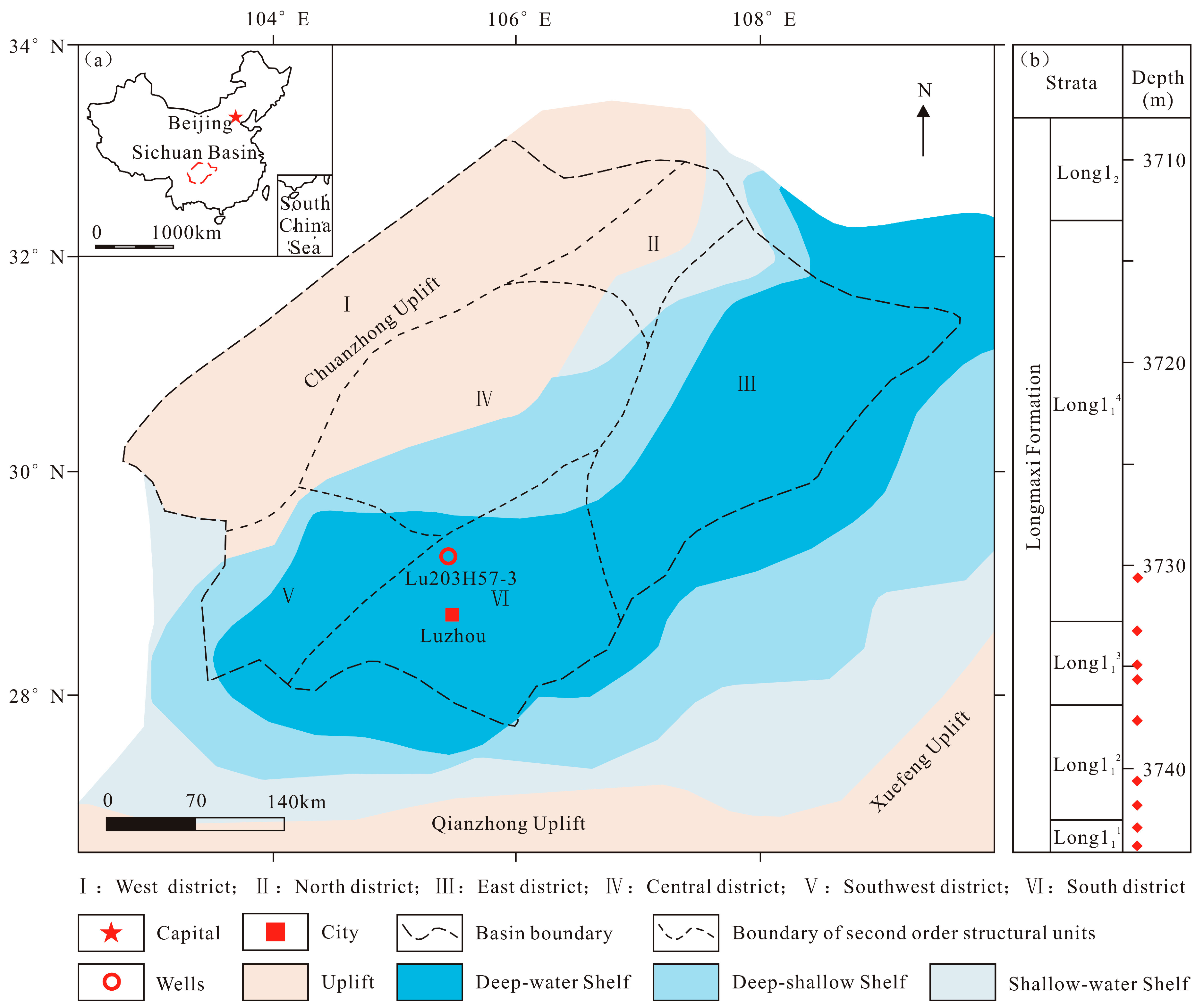
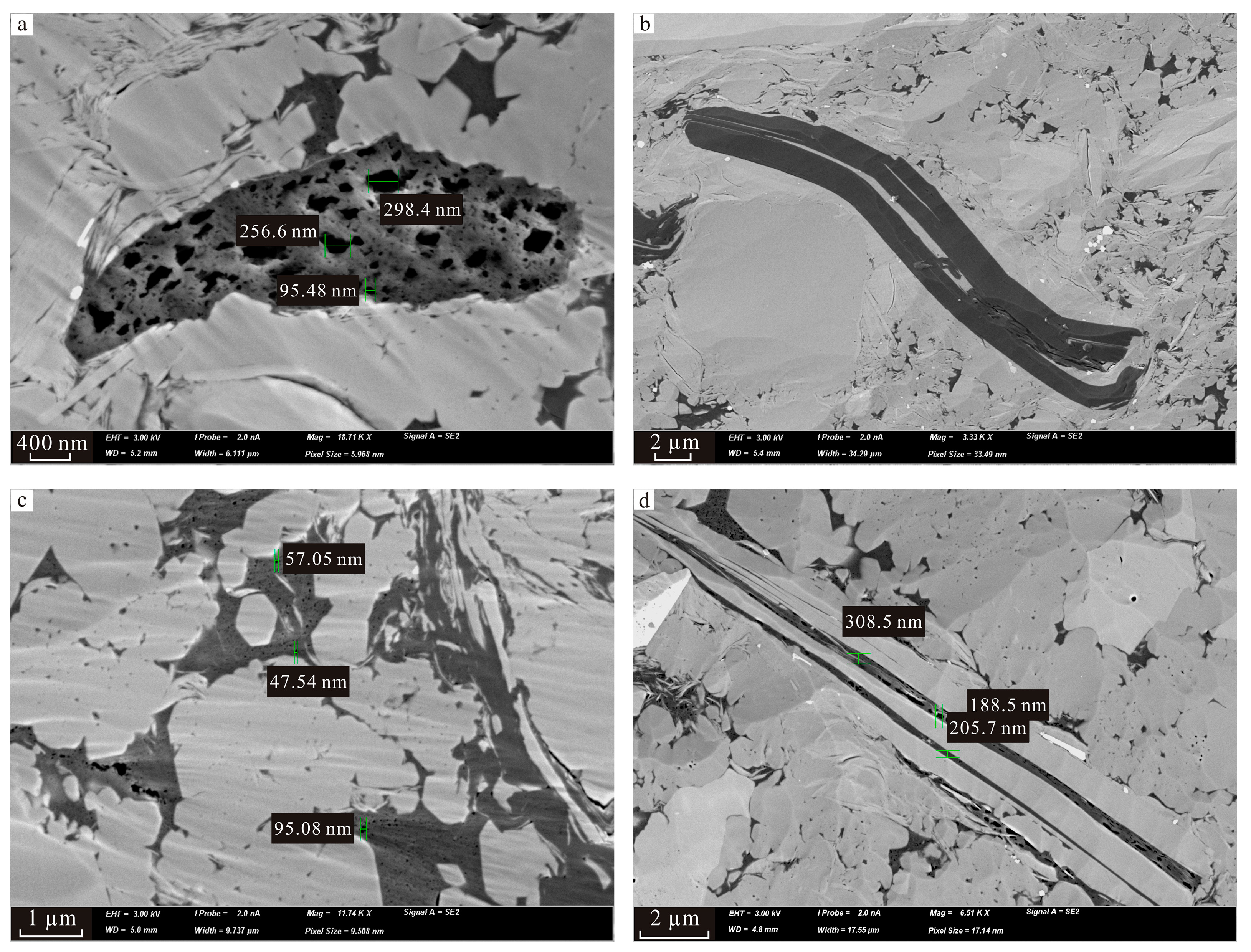
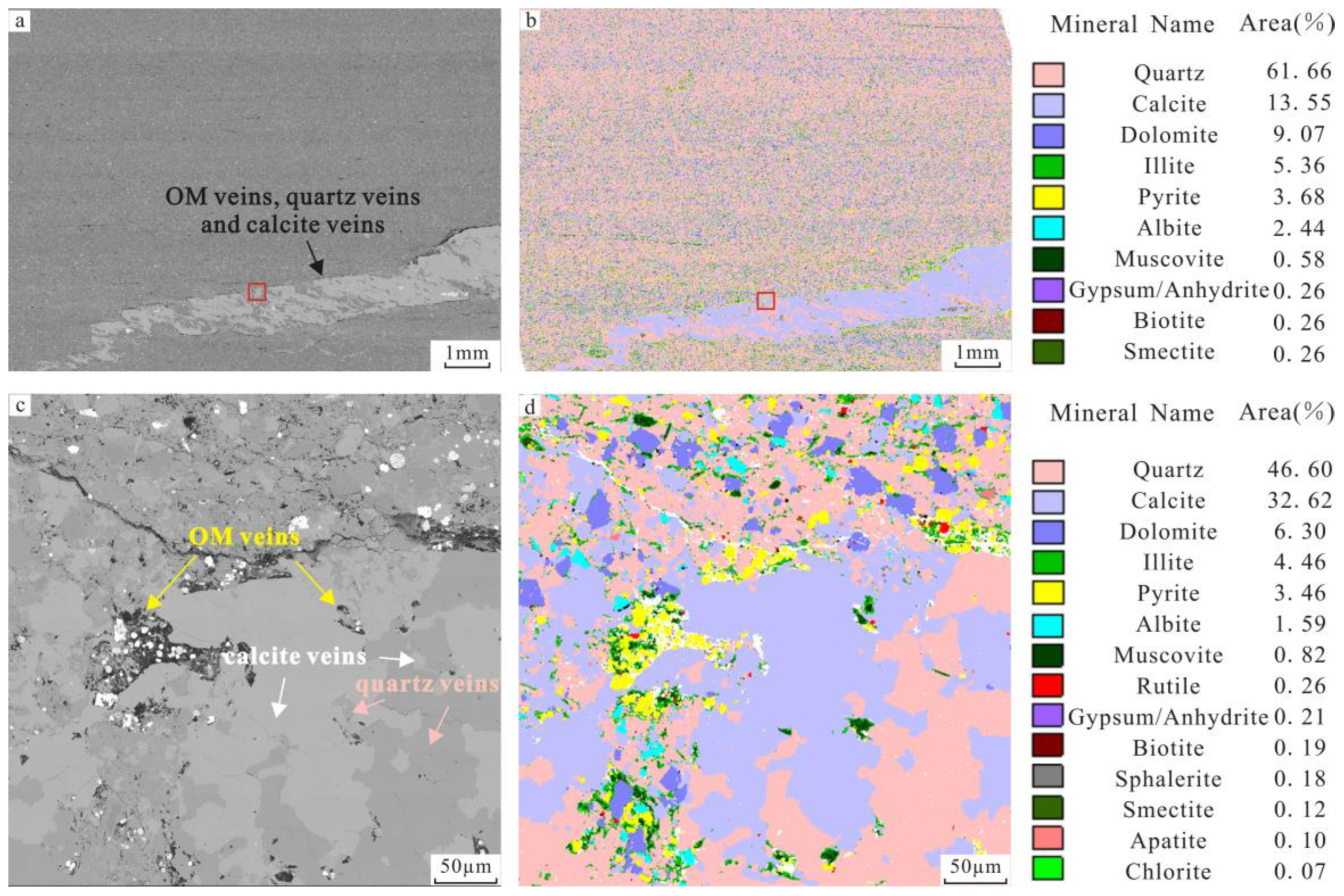
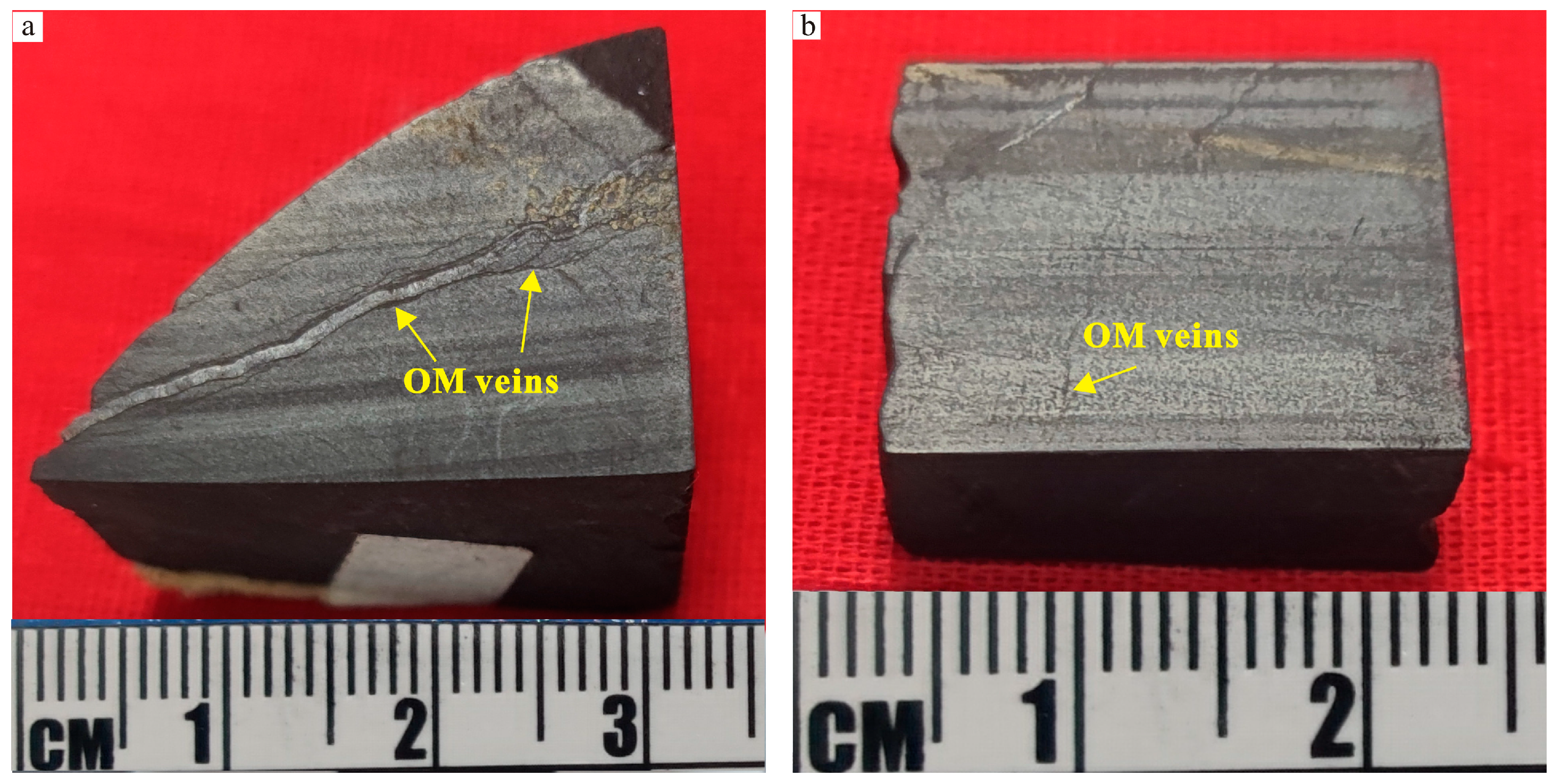

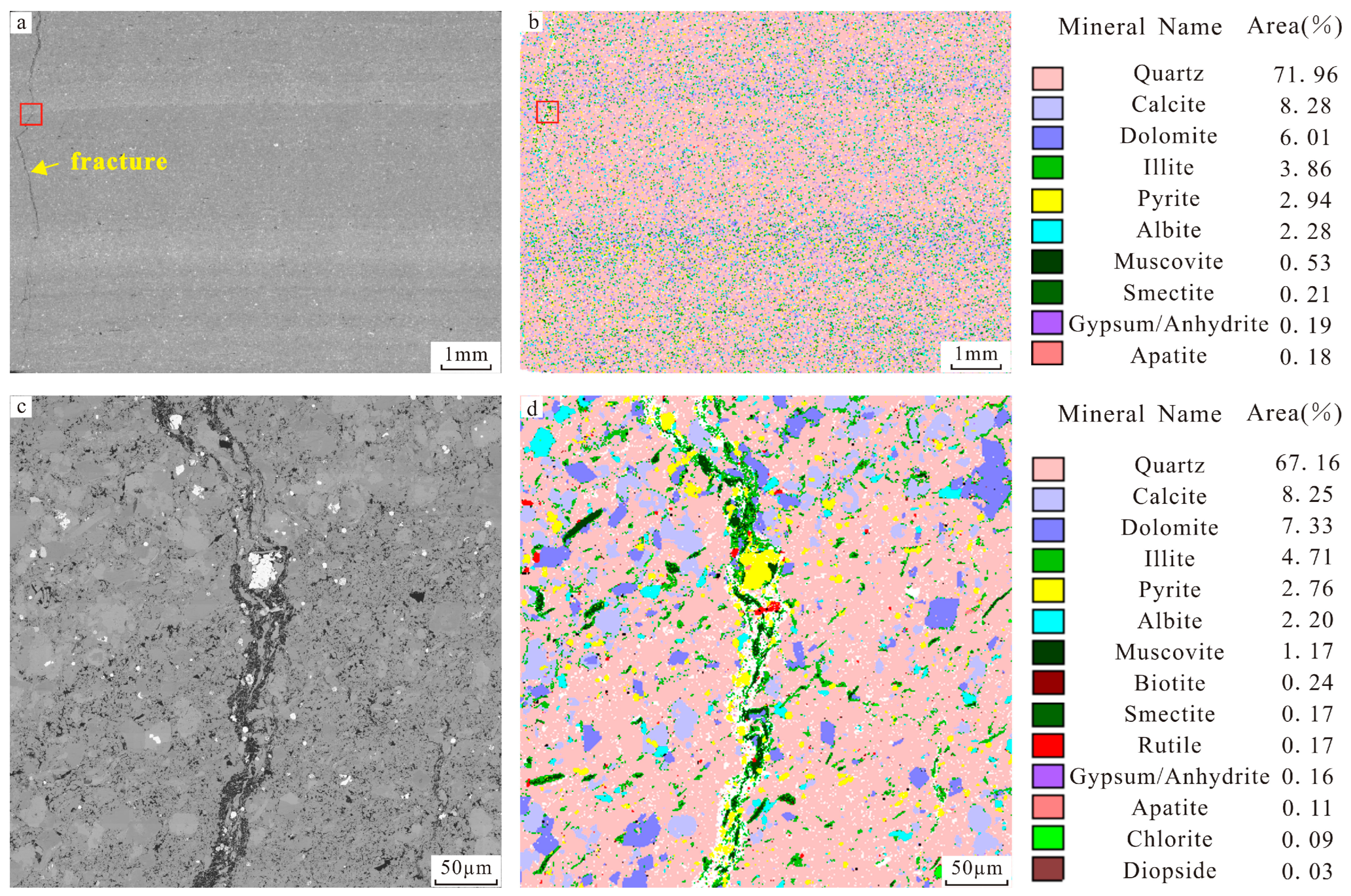

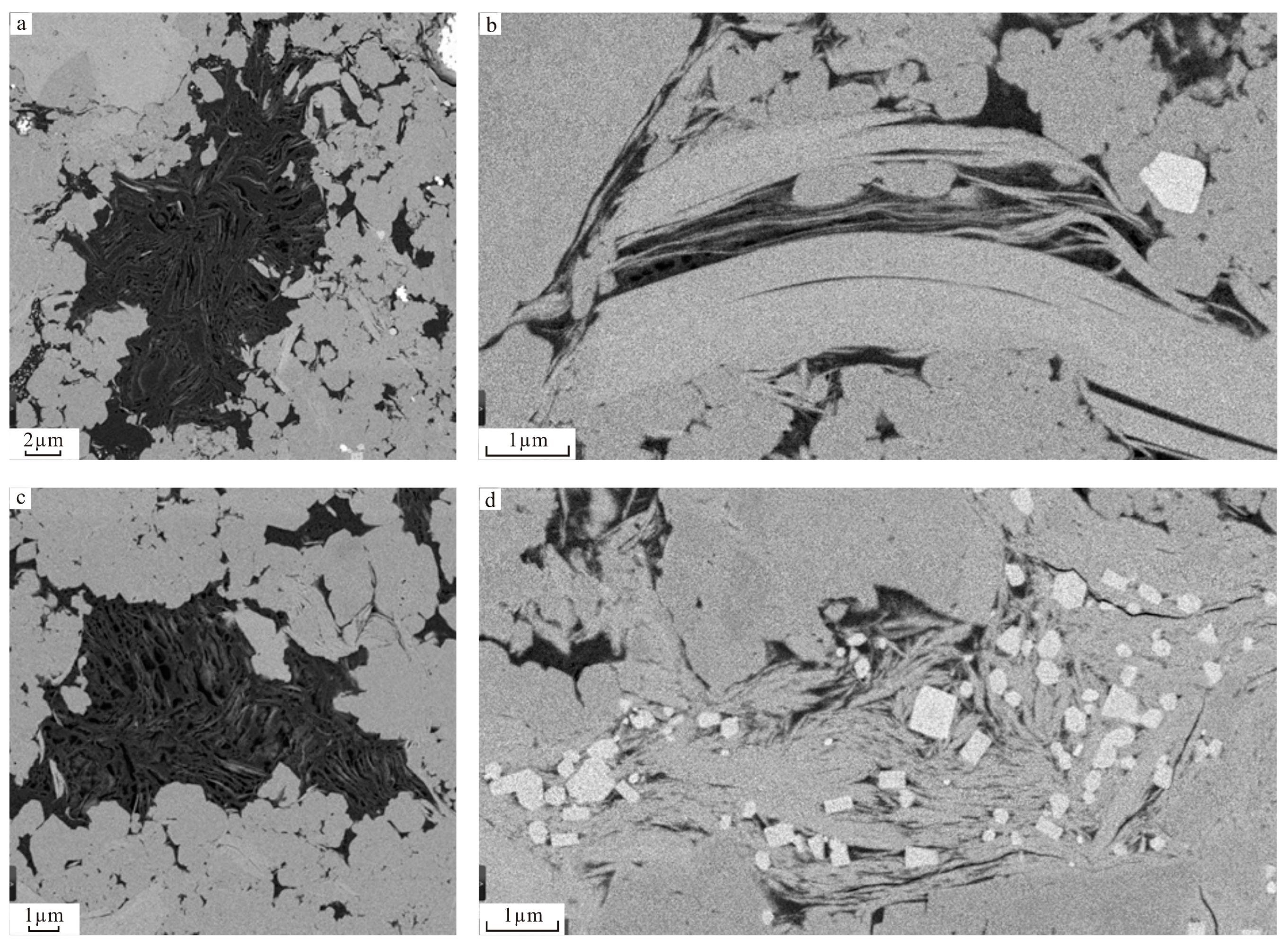


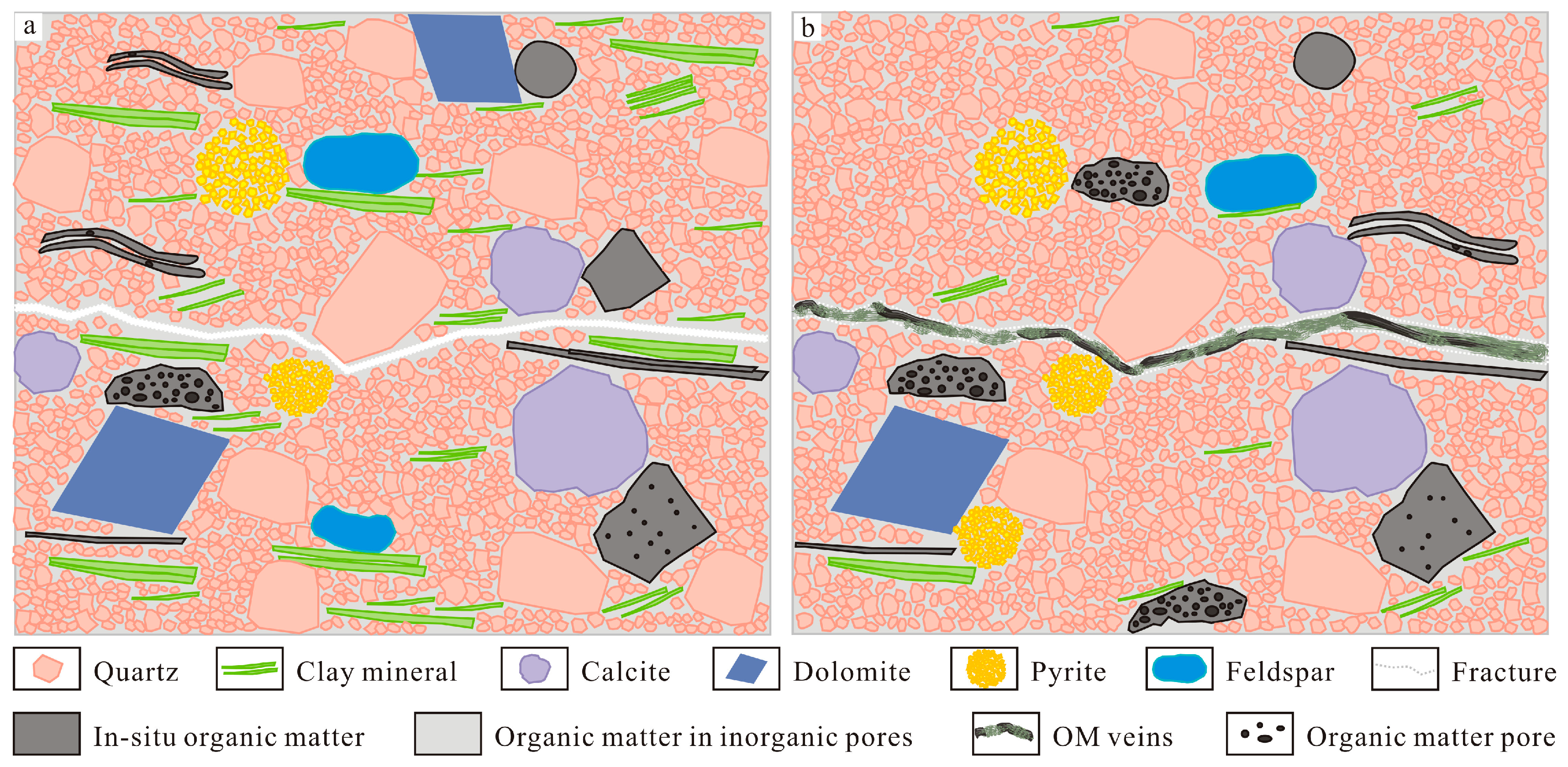
| Organic Matter Type | Pore-Forming Efficiency | Pore Characteristics |
|---|---|---|
| In situ organic matter | 0%~60% (avg. 28.5%) | The pores are alternate in size and dense, mostly 20~300 nm |
| Organic matter in inorganic pores | 3%~22% (avg. 10.7%) | The pores are small and dense, mostly 20~100 nm |
| Organic matter veins | 0.3%~2.9% (avg. 2.4%) | The pores are sparse, mostly 20~70 nm |
| Depth/m | Layer | Quartz Content/% | Calcite Content/% | Brittle Minerals (Quartz + Calcite) Content/% | Organic Porosity/% | Vein Development | Vein Types | TOC |
|---|---|---|---|---|---|---|---|---|
| 3730.7 | Long114 | 48.04 | 6.87 | 54.91 | 1.0 | - | - | 2.57 |
| 3733.2 | Long113 | 64.28 | 0.93 | 71.85 | 1.8 | - | - | 2.82 |
| 3734.9 | Long113 | 64.70 | 3.33 | 65.63 | 1.5 | - | - | 3.71 |
| 3735.6 | Long113 | 49.99 | 0.92 | 50.91 | 1.8 | + | Quartz veins and calcite veins | 3.81 |
| 3737.6 | Long112 | 58.85 | 3.28 | 62.13 | 2.5 | - | - | 4.10 |
| 3740.6 | Long112 | 59.58 | 10.71 | 70.29 | 1.8 | ++ | OM veins, quartz veins and calcite veins | 3.42 |
| 3741.8 | Long112 | 76.44 | 4.46 | 80.90 | 1.9 | + | OM veins | 3.15 |
| 3742.9 | Long111 | 69.66 | 13.55 | 83.21 | 2.7 | ++ | OM veins, quartz veins and calcite veins | 3.52 |
| 3743.8 | Long111 | 73.52 | 7.99 | 81.51 | 2.3 | + | OM veins | 4.68 |
Disclaimer/Publisher’s Note: The statements, opinions and data contained in all publications are solely those of the individual author(s) and contributor(s) and not of MDPI and/or the editor(s). MDPI and/or the editor(s) disclaim responsibility for any injury to people or property resulting from any ideas, methods, instructions or products referred to in the content. |
© 2023 by the authors. Licensee MDPI, Basel, Switzerland. This article is an open access article distributed under the terms and conditions of the Creative Commons Attribution (CC BY) license (https://creativecommons.org/licenses/by/4.0/).
Share and Cite
Wang, Y.; Jia, Y.; Wang, C.; Lin, W.; Zhang, J.; Han, D.; Ma, B.; Wang, H. Characteristics and Geological Significance of Organic Matter Veins in Shale Reservoir: A Case Study of the Silurian Longmaxi Formation in Luzhou Area, Sichuan Basin. Minerals 2023, 13, 1080. https://doi.org/10.3390/min13081080
Wang Y, Jia Y, Wang C, Lin W, Zhang J, Han D, Ma B, Wang H. Characteristics and Geological Significance of Organic Matter Veins in Shale Reservoir: A Case Study of the Silurian Longmaxi Formation in Luzhou Area, Sichuan Basin. Minerals. 2023; 13(8):1080. https://doi.org/10.3390/min13081080
Chicago/Turabian StyleWang, Yuanlin, Yunqian Jia, Chenchen Wang, Wei Lin, Jizhen Zhang, Denglin Han, Binyu Ma, and Huachao Wang. 2023. "Characteristics and Geological Significance of Organic Matter Veins in Shale Reservoir: A Case Study of the Silurian Longmaxi Formation in Luzhou Area, Sichuan Basin" Minerals 13, no. 8: 1080. https://doi.org/10.3390/min13081080







